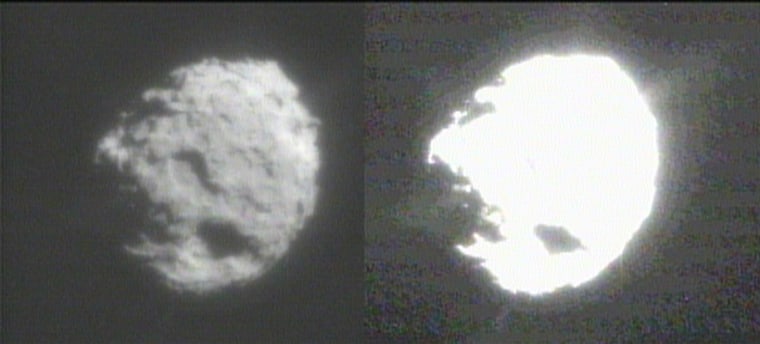A NASA spacecraft flew through the bright halo of a distant comet Friday and scooped up less than a thimbleful of dust that could someday shed light on how our solar system was formed.
NASA said its Stardust spacecraft passed within an estimated 149 miles (240 kilometers) of Comet Wild 2 as it plowed through the gossamer cloud that cloaks the dirty ball of ice and rock.
The spacecraft recorded bursts of particles spewed by active jets on the surface of the comet. It also snagged an untold number of dust specks for later study on Earth.
"We have successfully collected samples from a comet and we’re bringing them home," said Don Brownlee, the mission’s main scientist.
Mission members said the unmanned probe made its closest approach at 11:44 a.m. PT (2:44 p.m. ET), while traveling at a relative speed of 13,650 mph (21,840 kilometers per hour).
'Gem' of a photo
Shortly after the announcement, NASA released the first of 72 images Stardust took of the nucleus of the comet.
The black-and-white photo — taken by Stardust’s navigation camera from a distance of about 311 miles (500 kilometers) — showed craterlike features that scientists said may be pits in the ice caused by venting or erosion. A high-contrast version of the image showed at least five jets of material spewing from the nucleus.
"We instantly knew we had a gem," Brownlee said of the image, which is expected to add to science’s understanding of how comets behave.
"These are the best pictures ever taken of a comet," he said. "Although Stardust was designed to be a comet sample return mission, the fantastic details shown in these images greatly exceed our expectations."
Additional images, along with scientific measurements made of particles that hit the spacecraft’s instruments, were received from the spacecraft on Saturday. NASA said the data were being analyzed and that more images would be released to the public Monday or Tuesday.
Stardust's sample collector, which looks somewhat like a tennis racket, was designed to gather hundreds — if not thousands — of dust particles streaming from Wild 2 (pronounced Vilt-2) during the flyby 242 million miles from Earth. The comet’s nucleus is thought to be a jet-black ball perhaps just 3.3 miles (5.3 kilometers) across.
Mission members warned that comet flybys are risky, given the violent battering dust particles can give a spacecraft. Engineers gave Stardust armored bumpers to shield it during the encounter, and that appeared to protect the camera and other instruments from harm.
Solar system's building blocks
Scientists want to return samples of the particles to Earth for study because they represent pristine examples of the building blocks of our solar system dating back 4.6 billion years. They also believe the dust contains many of the organic molecules necessary for life.
"In this five-year journey we reached back in time to collect particles that haven’t been changed in 4.6 billion years," project manager Tom Duxbury said.
Members of the $200 million mission planned for Stardust to sweep back past the Earth in January 2006 and jettison a canister containing the particles, allowing it to fall to the ground in Utah.
If returned, the particles would represent the second robotic retrieval of extraterrestrial material since 1976, when the unmanned Soviet Luna 24 mission brought back samples of rock and soil from the moon. NASA’s Genesis spacecraft should be the first since then come September, when it returns samples of the solar wind it has collected in space.
